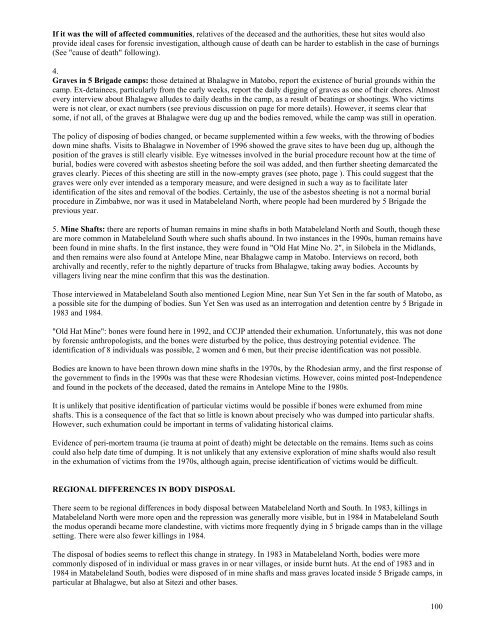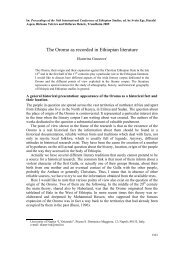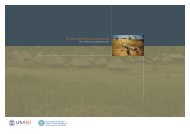MatabelelandReport
MatabelelandReport
MatabelelandReport
Create successful ePaper yourself
Turn your PDF publications into a flip-book with our unique Google optimized e-Paper software.
If it was the will of affected communities, relatives of the deceased and the authorities, these hut sites would also<br />
provide ideal cases for forensic investigation, although cause of death can be harder to establish in the case of burnings<br />
(See "cause of death" following).<br />
4.<br />
Graves in 5 Brigade camps: those detained at Bhalagwe in Matobo, report the existence of burial grounds within the<br />
camp. Ex-detainees, particularly from the early weeks, report the daily digging of graves as one of their chores. Almost<br />
every interview about Bhalagwe alludes to daily deaths in the camp, as a result of beatings or shootings. Who victims<br />
were is not clear, or exact numbers (see previous discussion on page for more details). However, it seems clear that<br />
some, if not all, of the graves at Bhalagwe were dug up and the bodies removed, while the camp was still in operation.<br />
The policy of disposing of bodies changed, or became supplemented within a few weeks, with the throwing of bodies<br />
down mine shafts. Visits to Bhalagwe in November of 1996 showed the grave sites to have been dug up, although the<br />
position of the graves is still clearly visible. Eye witnesses involved in the burial procedure recount how at the time of<br />
burial, bodies were covered with asbestos sheeting before the soil was added, and then further sheeting demarcated the<br />
graves clearly. Pieces of this sheeting are still in the now-empty graves (see photo, page ). This could suggest that the<br />
graves were only ever intended as a temporary measure, and were designed in such a way as to facilitate later<br />
identification of the sites and removal of the bodies. Certainly, the use of the asbestos sheeting is not a normal burial<br />
procedure in Zimbabwe, nor was it used in Matabeleland North, where people had been murdered by 5 Brigade the<br />
previous year.<br />
5. Mine Shafts: there are reports of human remains in mine shafts in both Matabeleland North and South, though these<br />
are more common in Matabeleland South where such shafts abound. In two instances in the 1990s, human remains have<br />
been found in mine shafts. In the first instance, they were found in "Old Hat Mine No. 2", in Silobela in the Midlands,<br />
and then remains were also found at Antelope Mine, near Bhalagwe camp in Matobo. Interviews on record, both<br />
archivally and recently, refer to the nightly departure of trucks from Bhalagwe, taking away bodies. Accounts by<br />
villagers living near the mine confirm that this was the destination.<br />
Those interviewed in Matabeleland South also mentioned Legion Mine, near Sun Yet Sen in the far south of Matobo, as<br />
a possible site for the dumping of bodies. Sun Yet Sen was used as an interrogation and detention centre by 5 Brigade in<br />
1983 and 1984.<br />
"Old Hat Mine": bones were found here in 1992, and CCJP attended their exhumation. Unfortunately, this was not done<br />
by forensic anthropologists, and the bones were disturbed by the police, thus destroying potential evidence. The<br />
identification of 8 individuals was possible, 2 women and 6 men, but their precise identification was not possible.<br />
Bodies are known to have been thrown down mine shafts in the 1970s, by the Rhodesian army, and the first response of<br />
the government to finds in the 1990s was that these were Rhodesian victims. However, coins minted post-Independence<br />
and found in the pockets of the deceased, dated the remains in Antelope Mine to the 1980s.<br />
It is unlikely that positive identification of particular victims would be possible if bones were exhumed from mine<br />
shafts. This is a consequence of the fact that so little is known about precisely who was dumped into particular shafts.<br />
However, such exhumation could be important in terms of validating historical claims.<br />
Evidence of peri-mortem trauma (ie trauma at point of death) might be detectable on the remains. Items such as coins<br />
could also help date time of dumping. It is not unlikely that any extensive exploration of mine shafts would also result<br />
in the exhumation of victims from the 1970s, although again, precise identification of victims would be difficult.<br />
REGIONAL DIFFERENCES IN BODY DISPOSAL<br />
There seem to be regional differences in body disposal between Matabeleland North and South. In 1983, killings in<br />
Matabeleland North were more open and the repression was generally more visible, but in 1984 in Matabeleland South<br />
the modus operandi became more clandestine, with victims more frequently dying in 5 brigade camps than in the village<br />
setting. There were also fewer killings in 1984.<br />
The disposal of bodies seems to reflect this change in strategy. In 1983 in Matabeleland North, bodies were more<br />
commonly disposed of in individual or mass graves in or near villages, or inside burnt huts. At the end of 1983 and in<br />
1984 in Matabeleland South, bodies were disposed of in mine shafts and mass graves located inside 5 Brigade camps, in<br />
particular at Bhalagwe, but also at Sitezi and other bases.<br />
100







